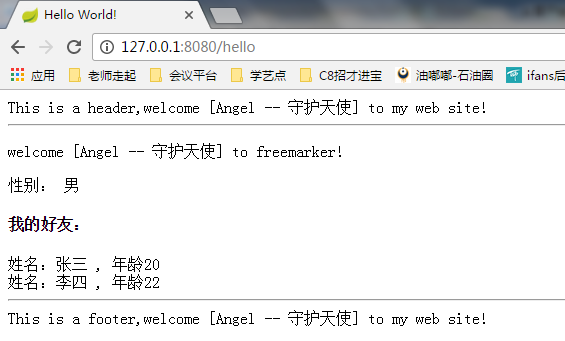最近有好久没有更新博客了,感谢小伙伴的默默支持,不知道是谁又打赏了我一个小红包,谢谢。
今天我们讲讲怎么在spring boot中使用模板引擎freemarker,先看看今天的大纲:
(1) freemarker介绍;
(2) 新建spring-boot-freemarker工程;
(3) 在pom.xml引入相关依赖;
(4) 编写启动类;
(5) 编写模板文件hello.ftl;
(6) 编写访问类hellocontroller;
(7) 测试;
(8) freemarker配置;
(9) freemarker常用语法;
(10) freemarker layout 布局
(1) freemarker介绍;
freemarker是一款模板引擎: 即一种基于模板和要改变的数据, 并用来生成输出文本(html网页、电子邮件、配置文件、源代码等)的通用工具。 它不是面向最终用户的,而是一个java类库,是一款程序员可以嵌入他们所开发产品的组件。
(2) 新建spring-boot-freemarker工程;
我们新建一个maven工程,取名为:spring-boot-freemarker
(3) 在pom.xml引入相关依赖;
这里使用freemarker需要引入相关依赖包:spring-boot-starter-freemarker,
|
1
2
3
4
5
6
7
8
9
10
11
12
13
14
15
16
17
18
19
20
21
22
23
24
25
26
27
28
29
30
31
32
33
34
35
36
37
38
39
40
41
42
43
44
45
46
47
48
49
50
51
|
<project xmlns="http://maven.apache.org/pom/4.0.0" xmlns:xsi="http://www.w3.org/2001/xmlschema-instance" xsi:schemalocation="http://maven.apache.org/pom/4.0.0 http://maven.apache.org/xsd/maven-4.0.0.xsd"> <modelversion>4.0.0</modelversion> <groupid>com.kfit</groupid> <artifactid>spring-boot-velocity</artifactid> <version>0.0.1-snapshot</version> <packaging>jar</packaging> <name>spring-boot-velocity</name> <url>http://maven.apache.org</url> <properties> <project.build.sourceencoding>utf-8</project.build.sourceencoding> <!-- jdk版本号,angel在这里使用1.8,大家修改为大家本地配置的jdk版本号即可 --> <java.version>1.8</java.version> </properties> <!-- spring boot 父节点依赖, 引入这个之后相关的引入就不需要添加version配置, spring boot会自动选择最合适的版本进行添加。 --> <parent> <groupid>org.springframework.boot</groupid> <artifactid>spring-boot-starter-parent</artifactid> <version>1.4.1.release</version><!-- 1.4.1.release , 1.3.3.release--> </parent> <dependencies> <dependency> <groupid>junit</groupid> <artifactid>junit</artifactid> <scope>test</scope> </dependency> <!-- spring boot web支持:mvc,aop... --> <dependency> <groupid>org.springframework.boot</groupid> <artifactid>spring-boot-starter-web</artifactid> </dependency> <!-- 引入freemarker的依赖包. --> <dependency> <groupid>org.springframework.boot</groupid> <artifactid>spring-boot-starter-freemarker</artifactid> </dependency> </dependencies> </project> |
(4) 编写启动类;
启动类没有什么特别之处,不过多介绍,请看代码:
|
1
2
3
4
5
6
7
8
9
10
11
12
13
14
15
16
17
|
package com.kfit; import org.springframework.boot.springapplication; import org.springframework.boot.autoconfigure.springbootapplication; /** * * @author angel --守护天使 * @version v.0.1 * @date 2016年10月4日 */@springbootapplicationpublic class app { publicstaticvoid main(string[] args) { springapplication.run(app.class, args); } } |
(5) 编写模板文件hello.ftl;
编写一个hello.ftl文件,此文件的路径在src/main/resources/templates下,其中hello.ftl文件的内容如下:
|
1
2
3
4
5
|
<html> <body> welcome ${name} to freemarker! </body> </html> |
(6) 编写访问类hellocontroller;
有了模板文件之后,我们需要有个controller控制类,能够访问到hello.ftl文件,这里也很简单,具体看如下代码:
|
1
2
3
4
5
6
7
8
9
10
11
12
13
14
15
16
17
18
19
20
21
22
23
|
package com.kfit.demo.web; import java.util.map; import org.springframework.stereotype.controller; import org.springframework.web.bind.annotation.requestmapping; /** * 测试velocity; * @author angel --守护天使 * @version v.0.1 * @date 2016年10月4日 */@controllerpublic class hellocontroller { @requestmapping("/hello") public string hello(map<string,object> map){ map.put("name", "[angel -- 守护天使]"); return "hello"; } } |
(7) 测试;
好了,到这里,我们就可以启动我们的程序进行测试了,访问地址:
http://127.0.0.1:8080/hello ,如果你在浏览器中看到如下信息:
welcome [angel -- 守护天使] to freemarker!
那么说明你的demo ok 了。
(8) freemarker配置;
在spring boot的application.properties属性文件中为freemarker提供了一些常用的配置,如下:
|
1
2
3
4
5
6
7
8
9
10
11
12
13
14
15
16
17
|
###########################################################freemarker (freemarkerautoconfiguration)########################################################spring.freemarker.allow-request-override=falsespring.freemarker.cache=truespring.freemarker.check-template-location=truespring.freemarker.charset=utf-8spring.freemarker.content-type=text/htmlspring.freemarker.expose-request-attributes=falsespring.freemarker.expose-session-attributes=falsespring.freemarker.expose-spring-macro-helpers=false#spring.freemarker.prefix=#spring.freemarker.request-context-attribute=#spring.freemarker.settings.*=#spring.freemarker.suffix=.ftl#spring.freemarker.template-loader-path=classpath:/templates/ #comma-separated list#spring.freemarker.view-names= # whitelist of view names that can be resolved |
(9) freemarker常用语法;
freemarker的语法并不是本节的重点,这里还是简单的介绍下几个常用的if else,list;
首先我们改造下hellocontroller的hello方法
|
1
2
3
4
5
6
7
8
9
10
11
12
13
14
15
16
17
|
@requestmapping("/hello") public string hello(map<string,object> map){ map.put("name", "[angel -- 守护天使]"); map.put("gender",1);//gender:性别,1:男;0:女; list<map<string,object>> friends =new arraylist<map<string,object>>(); map<string,object> friend = new hashmap<string,object>(); friend.put("name", "张三"); friend.put("age", 20); friends.add(friend); friend = new hashmap<string,object>(); friend.put("name", "李四"); friend.put("age", 22); friends.add(friend); map.put("friends", friends); return "hello"; } |
这里我们返回了gender和friends的列表;
接下来我们看看怎么在freemarker进行展示呢?
|
1
2
3
4
5
6
7
8
9
10
11
12
13
14
15
16
17
18
19
20
21
22
23
24
25
26
27
28
29
30
31
|
<!doctype html> <html xmlns="http://www.w3.org/1999/xhtml" xmlns:th="http://www.thymeleaf.org" xmlns:sec="http://www.thymeleaf.org/thymeleaf-extras-springsecurity3"> <head> <title>hello world!</title> </head> <body> <p> welcome ${name} to freemarker! </p> <p>性别: <#if gender==0> 女 <#elseif gender==1> 男 <#else> 保密 </#if> </p> <h4>我的好友:</h4> <#list friends as item> 姓名:${item.name} , 年龄${item.age} <br> </#list> </body> </html> |
(10) freemarker layout
freemarker layout主要处理具有相同内容的页面,比如每个网站的header和footer页面。
freemarker 的布局主要常见的两种方式是#import(“文件路径”)和#include(“文件路径”),其中import和include的区别在于,include常用于公共部分的页面,如果要使用<#assign username=“张三”>涉及到内部函数以及变量声明之类的,使用import进行导入,如果在import中的页面含有页面当前将不会进行渲染。 我们编写一个header和footer,其中的header使用include引入,footer页面也使用include引入。(当然freemarker 还有别的布局方式,这里只是介绍一种,请自行学习研究)
header.ftl内容:
|
1
2
3
4
|
<header> this is a header,welcome ${name} to my web site! </header> <hr> |
footer.ftl内容:
|
1
2
3
4
|
<hr> <footer> this is a footer,welcome ${name} to my web site! </footer> |
修改hello.ftl:
|
1
2
3
4
5
6
7
8
9
10
11
12
13
14
15
16
17
18
19
20
21
22
23
24
25
26
27
28
29
30
31
32
33
34
35
36
|
<!doctype html> <html xmlns="http://www.w3.org/1999/xhtml" xmlns:th="http://www.thymeleaf.org" xmlns:sec="http://www.thymeleaf.org/thymeleaf-extras-springsecurity3"> <head> <title>hello world!</title> </head> <body> <#include "/header.ftl" > <p> welcome ${name} to freemarker! </p> <p>性别: <#if gender==0> 女 <#elseif gender==1> 男 <#else> 保密 </#if> </p> <h4>我的好友:</h4> <#list friends as item> 姓名:${item.name} , 年龄${item.age} <br> </#list> <#include "/footer.ftl" > </body> </html> |
到这里就ok了,我们访问/hello页面,应该会看到如下图的效果:

以上就是本文的全部内容,希望对大家的学习有所帮助,也希望大家多多支持服务器之家。
原文链接:http://412887952-qq-com.iteye.com/blog/2335218















